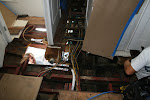Dear friends,
I was recently asked to consult on a problem on a large Trumpy. Climbing under her bottom in the aft area, the outer planking seemed to be coming unfastened. Grabbing the bottom of the rudder, one had worn out the packing bearing surface. As I walked to the back of the boat, the rudder looked straight, too straight to be exact. In the last few months, I’ve been getting a lot of questions about rudders and we just finished reworking Wishing Star’s rudder systems, so I’ll go into the subject with this letter.
I was discussing the problem with an old friend and incredible boat builder Michael Rybovich. You’re probably familiar with his family’s line of legendary sports fishing boats. I told him about a rudder problem that I had seen and his response was that with hydraulic steering, you can’t feel the vibration. They don’t train people to work on these old boats any more. Mike knows because his family has been building boats with cable and chain steering for a long, long time. Old sports fish captains swear by chain and cable because “You can feel the rudders.” I personally have only owned boats with chain and cable so that’s what I know first-hand. I would like to share it with you.
First, check the system. Vibrations at the helm could mean that the rudders are not tuned or they’re not “toed.” Next time when you are out of the water, grab the bottom of the rudder and try to move it from side to side. If there’s a fair amount of movement, it means the bearings are worn. There are two: one on top of the rudder table inside and the packing gland bearing. These bearings are made of an oil-impregnated bronze known as Bunsen Bronze or called bearing bronze. If most of the wear is on the top bearing, it is relatively easy to remove them. There are only four small bolts holding it in place. The rudders and bearings will need to be marked and kept together, with all the parts per side together. Any good shaft & prop shop should be able to do this work. Hopefully, you’re going to have this removed and installed by a professional. As for how much toe, each rudder should be toed in 5° each.
Let’s move on to servicing the steering system. What I love about these systems is they are simply oil and grease, pack and that’s it. Really. There are bronze cable blocks in the lazarette, engine room and under the steering station. Buy a can of dry graphite film lubricant and spray into the shivs. It is not a grease so it will stay. Graphite, pencil lead, is a great lubricant and it won’t drip. It works great on locks. You can find it at automotive stores, lock shops or most hardware stores.
Steering chains do wear out. They get longer and longer and can create sloppy steering. Edison Co. in Massachusetts has chain. It’s good to have a spare on board so don’t throw the old one out. Chains should get cleaned and greased once a season.
Now, let’s talk about play in the steering. The cables could need to be tightened. When doing so, make sure to not over tighten. When you turn the wheel, there should be a little slack on the opposite cable. If it is too tight, there will be no slack and this will put undue stress on pulleys and chain.
If the cable is set right, but there is slop at the wheel, that means that the chain has stretched out and should be replaced. I have been on many a Trumpy with a 30 to 60 year old chain so they last a long time.
On cables, I replaced one once after cutting it in half by mistake. If you ever do need to replace one, call me and I will walk you through it. Now, let’s head to the lazarette. The packing gland, every year or two, when the boat is hauled out, unbolt the top packing glands with two pipe wrenches, one for the lock nut the other for the packing nut. Lift the packing nut up, smear some grease onto the rudder shaft, drop the packing nut back down. Take your time to make sure that the threads line up and tighten down. The grease will come out the top so keep lots of rags handy. Then have someone turn the wheel to make sure it moves with ease. Set the lock nut. Smile. We have only one more thing to oil: the bearing and stop collars on the top of the table. Grease, oil or graphite will work well here.
Blog Archive
Facebook Badge
Chesapeake

After
Grand Lady

Original Auction Ad
Search This Blog
Followers
About Me

- Moores Marine
- Founded in 1986 by Maine trained boatbuilder, Jim Moores, the company has two locations: Riveria Beach, Fl., in Palm Beach County and Beaufort, North Carolina. We understand the anatomy of a wooden boat from a builder's perspective and the difference between yacht quality and work boats. Our work ranges from structural carpentry, mirror-like brightwork and paint, to shaft alignments, bow thruster and gyro installations.





